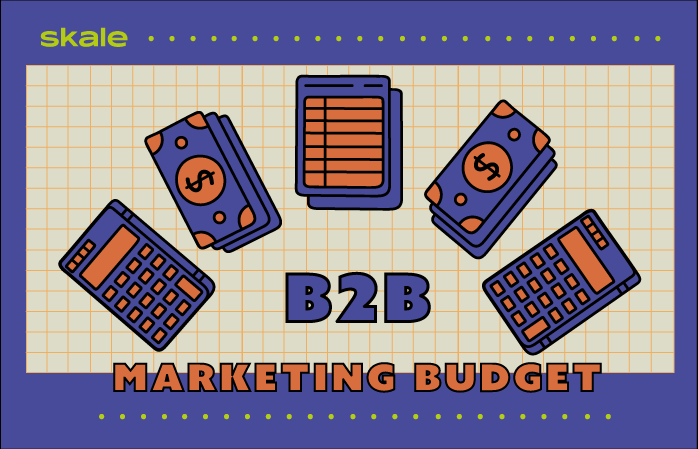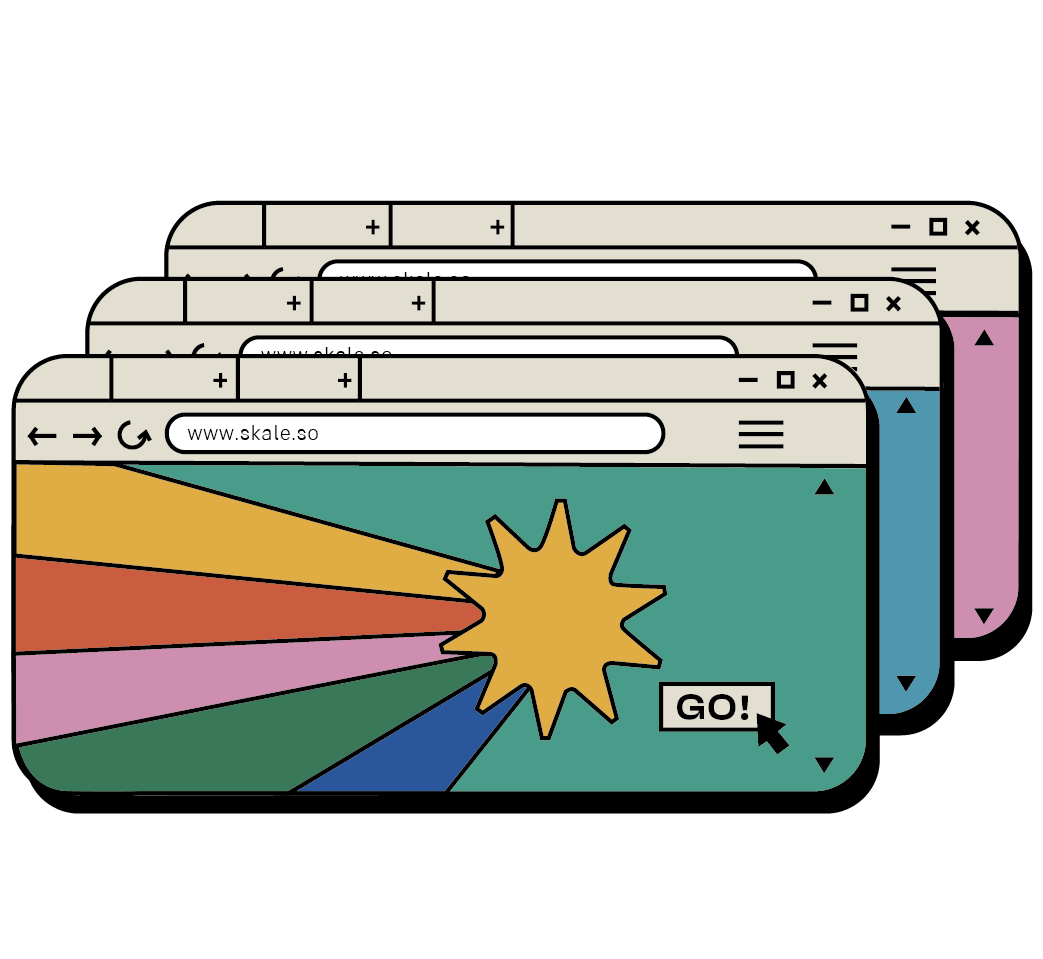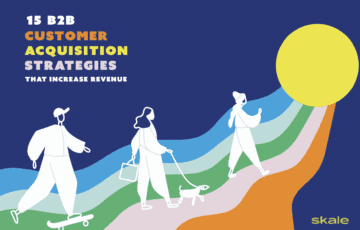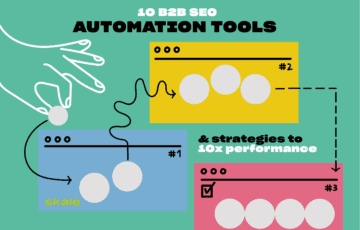
The Power of Partnership: 7 Benefits of Hiring a B2B SEO Agency
These benefits of hiring a B2B SEO agency illustrate why outsourcing your content can help you to drive new revenue for your business.


Manage your B2B marketing budget with confidence
Partner up with Skale’s team of experts and watch your conversion rate skyrocket
Schedule a callPicture this:
You’ve just developed an incredible marketing plan. You know it’s everything your company needs, and you can’t wait to share it with the team. There’s just one thing you haven’t considered — cost.
Sure, you’ve got a winning strategy, but you need to align it with your budget too. We’re here to help you do just that by exploring the important questions you need to consider as a B2B marketer.
First, let’s talk numbers.
As per the August 2021 CMO survey, companies spend 12.1% of their overall budget, and 6.1% of their company revenues on marketing. Speaking specifically on B2B companies, on average, B2B product companies spent 9.6% and B2B service companies spent 9% of their overall budgets on marketing.
A company’s marketing budget is driven by several factors—the company’s business needs, cash availability, and industry niche. You can use these figures as a benchmark when budgeting for your organization’s marketing efforts, but keep in mind your differentiating factors. Of course, the precise strategies you deploy depend on your marketing goals and whether you’re a B2B or B2C brand.
The marketing mix for both B2C and B2B is built on more or less the same marketing channels, including:
Before preparing marketing budgets, B2B marketing teams need to consider a few challenges.
A B2B sales cycle runs considerably longer than B2C purchases, which are often instantaneous. B2B products are often also more complex than B2C products. These challenges can make B2B sales feel less exciting — it’s your job to change this.
Get creative and add all the spark you can within the boundaries of your B2B marketing budget. If you’re a B2B SaaS marketer, you can always look for SaaS marketing inspiration online. Marketing technology (MarTech) also goes a long way in adding that spark. Previous research concluded that B2C marketers have adopted MarTech at a faster rate than B2C marketers.
However, new research argues that this is incorrect.
Research by the Content Marketing Institute shows B2B marketing teams are actually better at adopting MarTech than their B2C counterparts. In fact, 67% of the most successful B2B marketers surveyed described their company’s proficiency with content marketing technology as expert or advanced.
So, B2B marketers aren’t far behind when it comes to adopting MarTech at all. Although this means that as a B2B marketer, you’re more likely to see an increase in revenue with a better understanding of MarTech, it doesn’t change your upfront costs.
Many companies determine their B2B marketing spend using the MBR (Marketing Budget Ratio) formula. Here’s what the formula looks like:
Marketing investment ÷ Gross Revenue
B2C companies typically have higher MBRs, while B2B companies are relatively conservative. However, MBR still helps you benchmark against other companies in your industry.
That being said, don’t get swayed by numbers.
Based on your company’s specifics, the MBR you should aim for differs depending on how you decide to approach it.
For instance, the marketing efforts of a mature company vs. a startup are very different. Leading a startup’s marketing strategy involves working with smaller teams, tighter budgets, and ambitious goals to meet in a short time period.
Companies can also compute their MBR differently. For example, some companies may choose to include or exclude the costs of hiring a marketing agency, training, or research.
It’s also important to see where you are in terms of covering the digital marketing landscape, and how aggressive you are about leveling up brand awareness.
Using MBR is a good starting point. But simply relying on industry statistics to allocate a percentage of your total company budget to marketing can turn into a B2B marketing disaster. It’s essential to look inwards and understand what your company is able to do with the resources it has. Once you’ve done this, you can consider it in conjunction with industry stats. First, account for your business’s needs and goals, and study your sales funnel to strategize for your traditional advertising and digital marketing spend. Then compare the numbers with industry benchmarks — not the other way around!

Now, onto the fun part.
Roll up your sleeves and start thinking about where your marketing dollars will go.
First up, your KPIs. We’re not talking about broader business goals anymore, we’re talking about department specifics. For instance, improving your email marketing conversion rates by X%, or increasing your ARR by Y%.
You need tangible goals to measure success, so make sure you set them.
Pick your poisons — or as B2B marketers call them, marketing channels. Your marketing channel of choice depends on several factors, including the target audience and whether you’re service or product-focused.
Here are three key factors to bear in mind when it comes to choosing the right marketing channel for your business:
However, you should focus equally on both inbound and outbound marketing activities.
A mix of SEO, social media, and other inbound marketing channels provides your prospective clients a gateway to your brand. Inbound typically provides mouthwatering ROIs when done right.
For instance, a study found that content marketing can produce three times as many leads as traditional adverts like print ads or other traditional media.
If you don’t have an in-house team already, it makes sense to hire a B2B SEO agency that can help you with SaaS link building, SEO, and social media. This keeps your hiring costs low and within your marketing department’s budget.
Paid media still claims 25% of every company’s marketing budget, while search and digital advertising account for a relatively smaller 16%.
Outbound channels like email are still a powerhouse for boosting ROI though. The approach earns B2B marketing teams $42 back for each marketing dollar spent—that’s a 4200% ROI.
Once you have the channels narrowed down, look for potential loose ends.
Do you have the right tools and assets needed to deploy your marketing strategy? Think SEO tools, email marketing platforms, and any other tools that support your marketing plan, or help your report on it!
You should also spend some time assessing how the strategy will impact your operational costs. For instance, if you achieve your goal of increasing your ARR by X%, will you need a bigger customer support team?
It’s essential to consider the short and long-run effects of your marketing spend, and how that affects your company and customer lifecycle.
Let’s talk about some of the best ROI marketing channels that will help you hit the ground running as your B2B brand enters 2024.
93% of B2B marketers swear by email — and this isn’t set to change in 2024. If you’re telling yourself email is old school, think again. Emails bring subscribers, which become leads, and potentially new customers. Plus, that’s no to mention the impressive ROI of email marketing – $36 for every $1 spent.
Want to get started with email marketing? Here are some of the most effective options for B2B marketing:
Organic is all the rage, and SEO could be your ticket to scale fast in 2024. A UX-friendly website means nothing if people can’t find it. For this, you need to level up your on-page, off-page, and technical SEO game. Doing so can prove greatly beneficial for your business–like doubling sign ups in just three months.
An effective SEO strategy can be transformative for your business, from boosting organic signups to ranking highly in the SERPs for competitive keywords.
80% of decision-makers say they want to learn about your brand by reading articles, not looking at ads.
This isn’t because they’re avid readers, but because they want to make educated and informed decisions. Content marketing is no longer a nice-to-have, it’s a must-have.
For example, with a holistic SEO strategy that centered on content— from creating new content clusters to carrying out a full-scale content audit, Skale enabled Maze to scale their organic signups by over 283% in under six months. Existing content was repurposed, based on the findings of the audit, CTAs were optimized and the content quality was boosted.
There are dozens of channels you can work with, think podcasts, online communities & forums, the metaverse — pretty much anywhere can help you provide solutions with your product and brand.
The formula to calculate ROI is as follows:
[(Revenue attributable to marketing – Investment on marketing) ÷ Investment on Marketing] * 100
The challenge lies in determining the revenue attributable to marketing. It’s not complicated—just laborious.
Say you invested $50k in creating articles which led to you generating 1k sales-qualified leads. Of the 1K SQLs, 300 leads purchased your services—generating $150,000 in annual revenue.
Your ROI in this case?
($150k – $50k) ÷ $50k * 100 = 200%

Measure your SEO ROI the smart way
Track your marketing spend pain-free with our free SEO ROI tracker
Download hereA simple Google search will reveal a variety of tools that promise to help you minimize your budgeting woes. There are plenty out there, but we’ve narrowed it down to the options which are most worth your time.
Excel and Google Sheets are terrific (and free) tools for creating your budget. While it keeps your expenses lean, it’s no small task. You’ll likely need someone on the team dedicated to verifying the accuracy of inputs as there’s no room for error.
HubSpot templates are free as well, but provide more structure than starting from scratch on a blank spreadsheet. The eight, fully customizable templates enable you to budget for all components of your marketing mix including content, paid ads, and web redesign.
Hive9 is a B2B-focused tool for planning, budgeting, and analytics. It has a comprehensive dashboard that provides a broad overview of your campaign performance. The tool helps you channel your marketing efforts by allowing you to track where exactly your revenues are coming from.
Note: Download this free ROI tracker to start effectively measuring your SaaS SEO ROI.

Drive conversions with B2B SEO budget
Skale directs your SEO marketing budget to impact real business metrics
Learn moreYou can define your B2B marketing budget with a three-step process.
1. Define your company’s goals
2. Find the marketing channels you’d use to achieve those goals
3. Ensure that you have the resources in place to deploy your strategy on the chosen marketing channels
There’s no one-size-fits-all ROI that’s good for all B2B brands. However, you can use averages for different marketing channels as a benchmark when calculating ROI:
1. Google ads: $2 for every $1 invested
2. Personalized emails: 122% ROI
3. Mobile marketing: $10.50 for every $1
Learn more about
B2B SEO

The Power of Partnership: 7 Benefits of Hiring a B2B SEO Agency
These benefits of hiring a B2B SEO agency illustrate why outsourcing your content can help you to drive new revenue for your business.

15 B2B Customer Acquisition Strategies that Increase Revenue
Want to find new customers who truly value your business? We’re here to help you out with a list of the top 15 B2B customer acquisition strategies.

10 B2B SEO Automation Tools & Strategies to 10x Performance in 2024
Save time with the right B2B SEO automation tools and strategies that are sure to bring your marketing to the next level–we've listed them here.